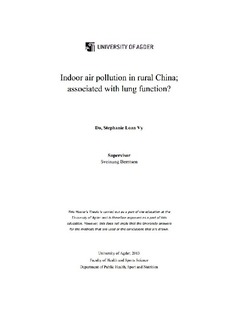Indoor air pollution in rural China; associated with lung function?
Master thesis
Permanent lenke
http://hdl.handle.net/11250/138873Utgivelsesdato
2013Metadata
Vis full innførselSamlinger
Sammendrag
Introduction: Approximately, half of the world population depends on biomass fuels as primary energy source. Indoor air pollutants are recently studied and considered as to be responsible for health burden in rural China. Chronic exposure to biomass combustion has been claimed to be associated with increased prevalence of respiratory symptoms, reduced lung function and the development of chronic obstructive pulmonary disease (COPD) The present study focuses on two main indoor air pollutants produced by biomass combustion: CO (Carbon monoxide) and PM (Particulate matter). The aim of the current study is to consider the association between these two main indoor pollutants and women’s lung function in chosen rural villages of Giuzhou Province of China. Methods: A cross-sectional study was carried out on the present study. A cluster of household survey was randomly selected to perform measurement of indoor air pollution. Sample subjects were women in the age of 30 years old or older. Spirometry was performed in all subjects. Results: There was no difference between participants with IAP measurement and those without IAP measurement. A significant association was found between CO concentration in living room and FEF50 (P=0.040). No statistically significant association was found between living-room CO concentration and FVC as well as FEV1. No significant association was found between PM2.5 concentration and lung function neither in kitchen nor in living room. Conclusion: CO concentration was negatively associated with women’s lung function, and there was no association between PM2.5 and women’s lung function.
Beskrivelse
Masteroppgave i folkehelsevitenskap – Universitetet i Agder 2013
